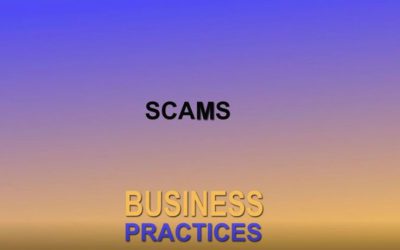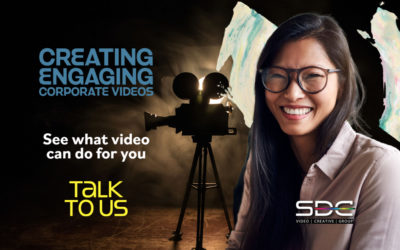VIDEO PRODUCTIONS TO CONSIDER FOR YOUR BUSINESS.
Before investing in any video production, you must give your video a job. Without a job, it will just sit on your webpage, not attracting much attention, with a price tag that does not justify its non-existent role.
So here is a collection of video types, each with a particular job. It should give you ideas on deploying video in any marketing, corporate, or communications role. But a few pointers first.
A YOUTUBE VIDEO IS NOT A TYPE OF VIDEO PRODUCTION.
A video type is defined by what they do. Therefore, a YouTube video is NOT a type of video; it is a platform. Certain types of video do better on YouTube than others, but it does not make a YouTube video a type of video.
It goes for any social media platform, whether it is Facebook, Snapchat, or TikTok. There are styles of video associated with these social media. For example, TikTok may capitalize on short-form videos that allow for a mixing of music, special effects, and filters, but it is still a platform. Likewise, it applies to other video platforms, such as email distribution.
A VIRAL VIDEO IS NOT A TYPE OF VIDEO.
A viral video is a popular video. The video is shared throughout social media and beyond. However, it says nothing about its purpose.
VIDEO TYPE: MARKETING VIDEOS THAT DO NOT PROMOTE THE BRAND DIRECTLY
Just because a video does not shout from the mountaintop about its brand does not mean you’re not raising brand awareness in your target community.
Think of the last conference you may have attended. So often on the wall are names of various brands that have supported the conference somehow. They are not advertisements pitching a product. They are just making you aware they are there and playing a role.
These non-brand-focused videos are similar. The brand is present in a video, but it’s not the focus of it.
INFORMATIONAL VIDEO PRODUCTIONS
These video productions inform the viewer on a subject matter that concerns the brand’s target audience. For example, if you have a health food brand, the informational video may be focused on specific lifestyle enhancements. On the other hand, a national travel authority may have a video on booking a great deal of hotels in the country.
MINI-DOCUMENTARY VIDEOS
A Video told as a story using factual information and interviews. As a result, they have a familiar documentary feel to them.
ENTERTAINMENT VIDEOS
Focused on storytelling, these usually have a narrative and fictional story. The brand’s presence may be part of the story but subtle. It may be product placement.
A few years back, BMW sponsored the short film series “The Hire”. It was eight short films and starred Clive Owen as a driver of a BMW. Each story revolved around Owen being hired as a driver of these cars for various reasons.
ADVERTISING AND PROMOTION
It is a category many first consider when considering producing a video. In some form, it’s all about pitching a product or service. It may be in the form of a commercial we watch on television, as the preroll to many YouTube videos, or an in-your-face infomercial, “It slices, it dices.”
Each is designed to sell but may sit in a different location in the sales funnel and reach out to potential clients or customers in different ways.
THE COMMERCIAL
Short and sweet, these attract attention by focusing on a specific consumer pain point. The best commercials appeal to an emotional core of the target audience without going into great detail, which would be impossible in a 30 or 60-second spot. Once the emotional center is reached, it is hoped the customer or client will find a rational reason to justify the spending. It works well for less complex buying decisions but not if you are buying fighter jets.
These types of commercials are changing as more people watch streaming services. In general, they are getting shorter. Six seconds is common for a spot.
Others roll before the start of a YouTube video you can click past. Only as easy to do for a television commercial if you record a show. But who does that now?
DEMONSTRATION VIDEOS
A demonstration video can be seen very much as a walk-through. Not so typical if the buying cycle is noticeably short; this type of video is usually reserved for more complex sales. The video is aimed at the potential buyers/clients who are saying, “Okay, you got my attention; tell me more.”
These video productions can be just an overview or a deep dive into the nitty-gritty details. It depends on where a potential client/buyer is in the buying cycle. With more complex products/services, more than one demonstration video may deal with different levels of understanding or purpose.
For example, a telecom software package may function the same, no matter who uses it, but a call centre focused on outbound marketing may use the software differently than in an inbound 911 call centre.
The demonstration video would highlight different approaches even if the software is the same.
LAUNCH VIDEOS
A launch video is a jump on creating and controlling a product’s or service’s “first impression.” It’s a promotional video that is designed to set the tone, establish your placement in the industry and get a big bang out of being the new kid on the block.
It has become an important option when the window of opportunity for the business is short and there is a need to create a splash early in the process.
Its target may be customers/clients, but it can also be focused on potential investors.
CROWDFUNDING VIDEO PRODUCTIONS
Crowdfunding is the new kid on the block regarding finding financing. Once allocated to the world of creatives trying to raise money for their art, video productions have become a significant vehicle for venture capitalists to find new investments. No longer are they projects that offer perks to supporters; equity crowdfunding has raised millions for projects that provide various types of ownership in businesses and inventions.
Whatever the case, the video’s target audience is the investor and what it promotes is the creator’s vision.
For potential investors, the video answers why they should help these people out. Therefore, these videos focus on the creatives and their vision.
In a more equity investment crowdfunding scenario, videos are similar, but the target audience is looking to make money – so they need to address this critical issue.
Nevertheless, both focus on the creator’s vision.
EXPLAINERS
It is a type of video production most people assume to be animated. But it does not have to be. However, since animation is an abstraction, it’s sometimes easier to use to explain conceptual issues that may be too expensive to produce with live-action.
This type of video may be considered similar to a demonstration video.
LIVE VIDEO OR WEBCASTING
It is very much as it says – live, as in Facebook live or YouTube live. Although not as popular as it was first expected to become, it can range from someone just talking to you through their webcam to productions that appear to be more like TV shows.
VIDEO CAMPAIGNS GENERATED BY USERS.
Video making has become so democratized that anyone with a phone can produce one. Of course, it is not the same as a higher-quality video, but if you look at TikTok, you can see the creative spirit it has launched.
And this is the primary goal of this type of video campaign. Get your buyers to create their videos. Catch the target audience’s imagination to extend your brand well into the world of social media.
STUNT VIDEOS
Remember flash mobs? That was a stunt video that was popular ten years ago. And they had a strong impact. Every so often, I still look at the Flash mob of Ode to Joy, Beethoven’s 9th Symphony. I honestly never get tired of it ( https://youtu.be/kbJcQYVtZMo )
Most of the time, people want the stunt to go viral, to spread the word widely. But they are also exceedingly tricky videos to create. If it is an actual stunt, you need much more than just a video production team – let alone a team of lawyers to cover liability issues. You also might find that you invest a lot into filming a stunt that no one cares about.
But there are simpler “stunts” for example “man-in-the-street” videos about something near and dear to the brand or candid camera-type videos that highlight and reward the participant with something relative to the brand.
EVENT VIDEOS
These video productions are about corporate or community events that would happen independently of the video being made. As a result, the videos can vary in style from a documentary to a much more traditional corporate look and feel.
The type of events can range from conferences to marketing events to trade shows.
More and more, these types of videos include live streaming to the web.
INFOMERCIALS
Sometimes considered home to the video version of stereotypical used car salesmen, we have become accustomed to these. They are over-the-top presentations (it slices, it dices)to show the on-camera demonstration of a product in front of a live audience that “woos and whaas” on cue.
They can also be in a very sober and dignified way. Most videos are about 30 minutes long and presented like a TV program. The product’s benefits and features are highlighted for a consumer audience.
DIGITAL SIGNAGE AND BILLBOARDS
Walk into many doctors’ offices, garages, and fast-food places, and you are likely to see them. They have local news followed by ads, both video and static. Others can be gigantic and fill Central Square in New York.
As the cost of digital displays drops, there will be more and more opportunities to use these assets for video marketing.
IN-STORE AND OFFICE VIDEOS
Generally designed for lobbies or places where people gather, they may focus on information or overall brand considerations.
CUSTOMER VIDEOS
Most corporate video productions are people talking about themselves and how great they are. It is always more convincing to have customers and clients talk about how great you are.
CUSTOMER TESTIMONIALS
Ever heard someone going on and on talking about themselves and how great they are? What is your level of trust? Do you believe them? But a former client/buyer talking about how great you are will carry more weight because there is no apparent conflict of interest. It appears more authentic. And that is the power of a testimonial.
Short and to the point, testimonials have credibility. They can go a long way to convincing a potential client you are worth the investment of their time and money.
CUSTOMER SUCCESS STORY
It is a more sophisticated version of a customer testimonial. It highlights your product through a story about your customers. For example, it may highlight the strengths and resourcefulness of your clients, but then your product or service becomes part of their success story.
3RD PARTY PRODUCT REVIEWS
Independent reviews of your product or service go a long way. Lots of influencers are willing to take on this task, but you need to have control over the content. They may like your product or maybe not. Using influencers has other issues. Some influencers’ reviews can be bought.
UNBOXING AND HAUL VIDEOS
It is a type of show-and-tell. Look at what I bought, watch me unbox it, and share the thrill.
These are 3rd party reviews. You have no control over the content. The comments are authentic. It is less about creating a video and more about organizing your products to be accessible to the hauler.
COMPANY MARKETING VIDEOS
Also called corporate videos, these video productions look at the company from its corporate perspective. While once the dominant style of video produced for corporations, its weakness lies in never being really outward looking or focusing on a particular issue important to the corporation that is less interesting to consumers.
COMPANY OVERVIEW VIDEOS
Once the standard go-to for businesses, it had the tone of a highly polished production narrated by a deep-voiced male that pounded you with details about how much the company is an industry leader.
It is a style that is disappearing because it is often parodied. Modern marketing is much more customer-focused.
RECRUITMENT VIDEOS
The explicit goal is to attract new employees and talent to a company by highlighting a solid work culture and extra benefits and values that come with a job. It can talk just as much about the challenges of the work as it does about group social activities or involvement in the community.
BEHIND-THE-SCENES VIDEOS
There is an insatiable appetite for behind-the-scenes videos. For example, the launch of a new product, moving into a new building, or prepping for a new public offering.
The whole process comes across as authentic and provides an insider look at the corporate culture.
CORPORATE EVENT PROMO VIDEOS
These are not about the event but rather aim to promote it.
CORPORATE INTERVIEWS
Focused on the rank-and-file of a corporation, most corporate interviews focus on the top of the organization and try to be forward-looking.
The approach may vary from essential talking-head type interviews to a highly produced “talk” show format with corporate leadership as guests.
At other times, topics may focus on new business lines or other activities.
PUBLIC & COMMUNITY RELATIONS
Corporate responsibility is gaining traction in many industries. Therefore, many organizations want to show a certain level of social interaction on various issues.
CORPORATE SOCIAL RESPONSIBILITY VIDEOS
These video productions are about how a business feels, believes, and interacts with the world. It goes beyond just sales to its role in society. A video showing social responsibility can be divisive.
INVESTOR RELATIONS
Publicly Traded Companies have reporting requirements. Video is not one of them. But a video simplifies issues to focus on the most important takeaways of a report.
VIDEO PRESS RELEASES
As in any press release, a video press release highlights and announces new services. The news media will use it as B-roll for background footage.
PUBLIC SERVICE ANNOUNCEMENTS.
While PSAs were originally the realm of charitable organizations and government, more and more businesses are stepping up to the plate to sponsor awareness campaigns.
CUSTOMER SUPPORT
These are usually quite simple videos that provide crucial support for the product.
CUSTOMER SUPPORT VIDEOS
Sometimes the most challenging issue faced by a customer is conceptual. It relates to questions about what the product or service can do. Therefore, these videos are often short and to the point to help a customer/client understand various aspects.
FAQ VIDEOS
Ask customer support staff. They know what is asked repeatedly. Frequently Asked Questions (FAQ) videos are straightforward and provide the answers to those questions.





